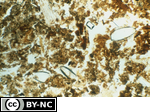Download Image
5.10 MB

ID # 153
Well-decomposed plant tissues, diatoms, and sponge spiculesFrom the Soil Micromorphology Slide Collection
Appropriate Grade Level(s)
- College-level
- Classroom Lectures
- Laboratory Activities
- Soil Microbiology
Data for 35-mm slide
Micromorphological description of slide: The soil fabric is dominated by units 80-120 µm that are often closely packed to form aggregations having 300-500 µm widths. These u nits consist of amorphous material (56.5%), well decomposed plant tissues (15.8%), diatoms (9.9%), and sponge spicules (often as fragments), mineral grains (1.8%), void space (15.9%). Occasional diatoms (Pinnularia sp., Cocconeis sp.), 150-200 µm lengths, and plant tissues (mainly 400-800 µm) occur randomly throughout the fine material. Percentage areal distributions were assessed from thin section by point counting approximately 3000 points on the thin section at 125x magnification.
Data for the horizon
Horizon sampled: 2C2 (110co2) Depth sampled: 258-273 cm
Physical and chemical data available: 2c2 (IIOco2l (156-61 3): pH = 5.4, c = 21.1 %, N = 1.4%, ash = 57.2%
Macromorphological description of horizon: 10 YR 3/2 sedge-sedimentary peat; weakly fibrous.
Micromorphological description of horizon: See references
Data for thin section
Preparation of sample: Acetone Impregnating medium: Polyester resin Thickness of section: 30 µm approximately Orientation of section: Vertical
Soil Classification U.S.: Entisol
F.A.O.: Gleysol
Canada: Limno Humisol
Elevation: 95 m above sea level Physiographic position: Basin swamp Topography and hill slope position: Leve Parent material: Peat material (woody-sedge sedimentary, sedge-sedimentary and sedimentary)
Soil climatic data and/or soil water balance: Mesic mild humid [Soil Climates of Canada map (1975)]
Vegetation: Dominant vegetation in basin swamp is Spiarea douqlasii (80% cover) and Salix sp. (10% cover)
Micromorphological description of slide: The soil fabric is dominated by units 80-120 µm that are often closely packed to form aggregations having 300-500 µm widths. These u nits consist of amorphous material (56.5%), well decomposed plant tissues (15.8%), diatoms (9.9%), and sponge spicules (often as fragments), mineral grains (1.8%), void space (15.9%). Occasional diatoms (Pinnularia sp., Cocconeis sp.), 150-200 µm lengths, and plant tissues (mainly 400-800 µm) occur randomly throughout the fine material. Percentage areal distributions were assessed from thin section by point counting approximately 3000 points on the thin section at 125x magnification.
Data for the horizon
Horizon sampled: 2C2 (110co2) Depth sampled: 258-273 cm
Physical and chemical data available: 2c2 (IIOco2l (156-61 3): pH = 5.4, c = 21.1 %, N = 1.4%, ash = 57.2%
Macromorphological description of horizon: 10 YR 3/2 sedge-sedimentary peat; weakly fibrous.
Micromorphological description of horizon: See references
Data for thin section
Preparation of sample: Acetone Impregnating medium: Polyester resin Thickness of section: 30 µm approximately Orientation of section: Vertical
Soil Classification U.S.: Entisol
F.A.O.: Gleysol
Canada: Limno Humisol
Elevation: 95 m above sea level Physiographic position: Basin swamp Topography and hill slope position: Leve Parent material: Peat material (woody-sedge sedimentary, sedge-sedimentary and sedimentary)
Soil climatic data and/or soil water balance: Mesic mild humid [Soil Climates of Canada map (1975)]
Vegetation: Dominant vegetation in basin swamp is Spiarea douqlasii (80% cover) and Salix sp. (10% cover)
Method
Frame length: 1.0 mm
Light mode: Partially cross polarized
Light mode: Partially cross polarized
References
Fox, C. A. and C. Tarnocai. 1989. The micromorphology of a sedimentary peat deposit from the Pacific temperate wetland region of Canada. p. 311-319. !.!:! L. A Douglas (ed.). Soil micromorphology: A basic and applied science. Proc. 8th IWMSM. Elsevier, New York. Tarnocai, C. and Schuppli, P. 1987. Sedimentary peat i n Canadian peatlands. p. 25-37 In C. D. A. Rubec and R.P. Overend (eds.) Proc. Symposium '87 Wetlands/Peatlands. Edmonton, Canada.Source - C. A. Fox
Peer Review: Yes
Credit this item to: SSSAMedia Date: 1993-01-01
Provided By: (SSSA) Soil Science Society of America
Author(s)/Creator(s)
-
* Soil Science Society of America
SSSA
membership@soils.org
Submitted By: Dr. Antonio Costa De Oliveira
Keywords
- Biological Features
- 2C2 (110co2)
- micromorphology
- Well-decomposed plant tissues, diatoms, and sponge spicules
Comments
Please login to submit a comment.
Log In to your account
Already a member, certified, or existing customer?*
* Cookies must be accepted to log in.
Not sure if you have an account?
Check Your Email
Join Us!
Connect with members and access the information you need.
Learn more.
Ready to Join?
If you have an account, login on the left. Not sure if you have an account or need to create one? Check your email with the link above. We look forward to welcoming you.